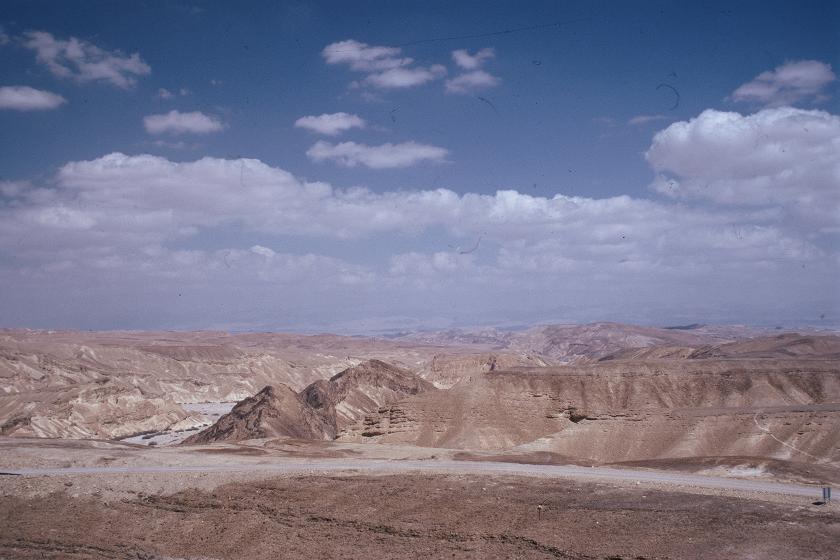Researchers from the Hebrew University found that the forms of the landscape in the Negev were preserved for 1.8 million years and were among the oldest in the world

Constant change to the surface occurs due to exposure to movements of water and air, freezing and thawing processes as well as long-term changes caused by volcanic activity and plate movement (tectonic activity). The constant change of the Earth's surface occurs more quickly in the mountains and more slowly in the deserts, especially in those where the level of tectonic activity is almost non-existent.
Research - led by Dr. Ari Matmon from the Institute of Earth Sciences at the Hebrew University and Dr. Rivka Amit from the Israel Geological Institute - conducted in the Faran plains in the central Negev found that a large area has been preserved as it is for 1.8 million years. This means that the surface today is the same surface on which the ancient inhabitants of the area walked. The research was done as part of a qualified thesis by Uri Simchai from the Institute of Earth Sciences at the Hebrew University.
Desert paving is a weave of natural stone pebbles that are densely combined and cover large areas of land in desert areas. The researchers dated the age of the desert pavement in the Farn Plains by measuring the concentration of rare isotopes created by interaction between cosmic radiation and the surface. One of the isotopes 10Be is formed only in the upper layer of the surface and by measuring its concentration it is possible to deduce the exposure time of the surface to the sky.
"The area we dated most likely represents large areas of the Arabian and Sahara deserts," said Dr. Ari Matmon. "We hope to be able to collect samples from other regions of the Sahara and draw conclusions on a global scale regarding these ancient surfaces," he added.
The dating of the desert pavement in the Paran Plains shows that large parts of the landscape have not weathered for nearly two million years. These parts of the landscape are among the oldest landscape forms that have been dated on the face of the earth.
According to Dr. Matmon, "Although longer exposure times have been measured on individual samples in other parts of the world, they do not indicate the age of the landscape in which they are found. On the other hand, the examples from the Paran Plain testify to the age of the entire landscape around them. Since there is a close correlation between the age of the desert pavement and the age of the surface, we will extend the age of the surface, and we did not choose the unusual stones scattered on the surface."
"The results show that in flat and arid areas where the level of tectonic activity is lower and the rocks are resistant to weathering, the surface can be preserved for millions of years. This is a hypothesis that we were not sure about until now," Dr. Matmon concluded.
The research was published in the latest edition of the Geological Society of America Bulletin.

7 תגובות
It's nice to know something new about the Paran Plain and especially what we learned about it in the Negev
What I learned mainly from the article is that in arid areas where the tectonic activity is low, these areas are more preserved and the weathering processes are slower.
A question for Dr. Matmon, can areas like the Australian desert give the same answer and conclusion as the Paran desert? Refer to the Ulero area, the big rock (the wave) found in the Australian desert.
Ido this sounds like good material for a Jules Varney book or screenplay. By the way, the impact of the meteor on the earth in the Gulf of Mexico area, which is claimed to be one of the reasons for the extinction of the dinosaurs in the world, this event happened after the continents had already separated to the best of my memory and were not called Gondwana.
A question for the geologists among us...
It is known that the Gunwana continent was connected. That is, the Earth was asymmetric, when one side has more weight (the Gondwana continent - there is simply more material at a greater distance from the Earth's core) and on the other side less weight (the Earth's mantle is a fraction shorter than its core).
That is, the rotation of the earth was not exactly balanced.
The question is how did it get to this state that is not in equilibrium?
I thought of an idea: maybe it has to do with the impact of the meteor that separated the Earth and the Moon, and at the point of separation the highest piece remained (farthest from the core), and that after a while it slowly subsided and became the Gondwana continent, which then dispersed into plates that strive to sew on the Earth uniformly so that the weight of Will the material in the ball be distributed in equilibrium with respect to its rotation?
It can be assumed that the surface of Antarctica has not weathered for a longer time.
Cool